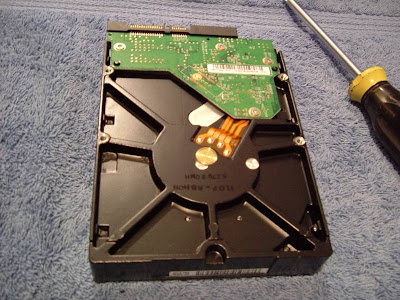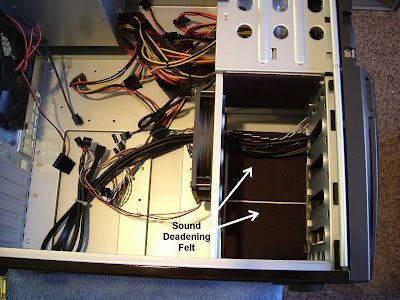Test System:
 |
| LG Blu-Ray Write/Read Drive Model WH16NS40 |
Seven-year-old mini-tower computer, home-built from an Intel DP35DP motherboard hosting an E6750 CPU with dual 2.66 GHz processors, 8 GB memory at 800 MHz, system bus 1066 MHz, running Windows Vista Ultimate. Hard disks are SATA 2TB Seagate hybrid disks.
The system is used as a computer, not as a video player. This review is about data backup. It should apply to copying video files as well, but you might want a newer, faster CPU to actually play or manipulate the video files. The owners' manual lists the E6750 CPU at 2.66 GHz as the minimum system.
The originally-installed Samsung SH-203B DVD Drive is still in place and functioning well after seven years. It can read and write DVD+R DL (dual layer) discs, though I only use it with standard and archival single-layer DVD's. Each month, sometimes more often, I create a backup copy of our own important files (not system files or application executables) on a MAM-A DVD-R gold archival disc for long-term storage, then copy that disc to regular DVD's for shorter-term offsite storage. Those important files have grown beyond the DVD's 4.7GB capacity, however, so the new LG Blu-Ray Disc (BD) Drive will bump that limit up to about 25GB. A firmware update from version 1.00 to 1.01-A0 is available for the drive but not yet installed. (First rule of life: If it works, you can't fix it.)
Test Method:
The new BD drive was installed in the mini-tower just below the DVD drive. The generic
Windows Vista software was used to write each disc initially. ISO Recorder 3.1 was used to restore each disc back to an ISO file, or to write that out to another disc. The following tests were performed to demonstrate single-drive data integrity as well as cross-drive data integrity:
• CD read: On the BD drive, restore two of our oldest archival CD's, going back to 1997. No read errors. Open a few files to verify data integrity.
• CD write/read, using Verbatim CD-R discs: Write a disc on each drive, restore each disc back to a desktop ISO file using each drive (four ISO files). No errors reported. With the Windows utility called comp, compare the two ISO's which were created from a disc written on one drive and restored from the other. This is a byte-for-byte comparison, and no differences were reported.
• DVD write/read, using TDK DVD-R discs: Same procedure as for CD's. No errors, no differences.
• DVD+R DL write/read, using Verbatim DVD+R DL discs: Same procedure as for CD's. The discs were filled to about 5.25GB, so that both disc layers would be used. No errors, no differences.
• BD-R write/read, using Verbatim 25GB 6x BD-R discs: Write a disc containing 21 GB of data including thousands of files (photos). Restore that back to an ISO. Write the ISO to another BD-R disc, restore that back to a second ISO, compare. No errors, no differences.
• BD-R 50GB, 100GB, and 128GB: Not tested - I don't need this functionality now, but I have no reason to doubt that it will work when it is needed, and perhaps disc prices will be better.
Data integrity test results:
The LG Blu-Ray Disc Rewriter Model WH16NS40 performed perfectly. I am impressed, and I now have renewed confidence in the old Samsung DVD drive as well.
Vista Speed-display Issue:
On this "old" Vista system the writing speed, estimated time left, and progress bar were all displayed incorrectly for the BD discs. Specifically, the Windows software reported that it intended to write at 39x, and the ISO Recorder program thought it would write at 351x. I seriously doubt that either was correct.
For both drives and all discs, I always allowed the write to take place at the maximum displayed speed (i.e. 39x or 351x), not attempting to reduce it. I have no idea what the actual write speed was for the BD discs, and I did not time any of the operations, but the data files were obviously recorded without error.
First actual Blu-Ray backup:
• Write encrypted and unencrypted files to a Delkin 6x 25GB Archival Gold BD-R.
• Restore that disc back to the desktop as an ISO file.
• Write that ISO to each of three Verbatim 6x 25GB BD-R discs for offsite storage.
• Open and verify some encrypted files on the last of those discs as a final check.
 This procedure worked flawlessly, backing up about 12GB, except that one of the Verbatim BD-R discs failed immediately when ISO Recorder 3.1 tried to write to it. That one disc was discarded with no attempt at diagnosis. I attribute the failure to the disc, not the drive, and comments on other blogs confirm that such failures can occur.
This procedure worked flawlessly, backing up about 12GB, except that one of the Verbatim BD-R discs failed immediately when ISO Recorder 3.1 tried to write to it. That one disc was discarded with no attempt at diagnosis. I attribute the failure to the disc, not the drive, and comments on other blogs confirm that such failures can occur.I believe that this process creates archival Blu-Ray discs which will last at least as long as there are drives capable of reading them. The Delkin Archival Gold BD-R discs cost me about $10 each in a pack of of 5, and the Verbatim BD-R discs about $1 each in a spindle of 25. Both are cheaper in larger quantities, and other brands are available. The LG Owner's Manual recommends Sony and Panasonic discs for BD-R 25GB, but does not say whether Delkin or Verbatim discs were ever tested.
Blu-Ray versus Flash for Archival Storage:
Removable-media technology seems to be moving away from optical discs and toward USB flash drives these days, and video is increasingly downloadable, so Blu-Ray discs may never enjoy the popularity of DVD's. Flash for archival storage is controversial, however, and it is still at least as expensive as Blu-Ray for similar capacity, so Blu-Ray is a better choice for now.























